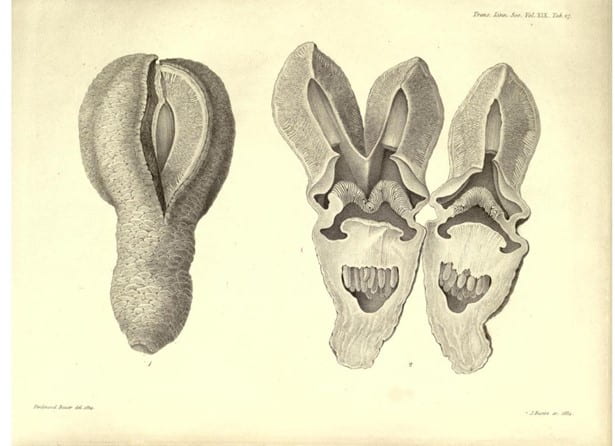By Katherine Arnold
At the 1836 meeting of the Gesellschaft Deutscher Naturforscher und Ärzte (The Society of German Naturalists and Physicians) in Jena, Gustav Kunze of Leipzig University presented a dried specimen of Hydnora africana, “a remarkable Asarine which grows parasitic on the large Euphorbias in the Carro [sic]” in the Western Cape region of South Africa. Kunze’s identification of Hydnora as belonging to the Asarina family reveals the lack of knowledge European botanists had of the plant, whose curious appearance and morphology had proven a sort of botanical puzzle since its European debut in the late eighteenth century. Although it was common to misinterpret botanical material arriving from overseas, Hydnora posed a particular challenge to the developing taxonomies of nineteenth-century European botany, primarily because of its most unusual attribute: parasitism.
Parasitic plants are characterized by the ability to feed directly on other plants, invading the host’s roots or shoots through parasitic structures called haustoria. Hydnora, found in the semi-arid regions of the northwestern Cape and southern Namibia, is a root holoparasite that grows almost completely subterranean. After leaching enough energy from its spurge host, a fleshy orange-pink flower emerges, releasing a fetid odor to attract its carrion and dung beetle pollinators. The Africans and Boer farmers who lived in the area called it jakkalskos, or jackal food, and it is thought to have a sweet and starchy taste. In ethnobotanical practice, the rhizomes of Hydnora, called uMayumbuka in isiZulu and isiXhosa, are used and traded to treat diarrhea, piles, acne, menstrual problems, stomach cramps, and to stop bleeding.
Colonial specimens like Hydnora were vital to the blossoming of botany as an academic discipline. Not only were they essential to the collectors engaged in its commercial trade and to naturalists attempting to classify and order the natural world, but they were also at the heart of transnational and trans-imperial networks of communication and exchange. With the advent of the material turn, historians have increasingly looked to objects as primary sources to trace the global production and movement of knowledge. In a similar way, the history of science has shown that, by refocusing narratives through the existence and agency of the nonhuman (or other-than-human), objects and organisms were implicated within histories of violence and expansion. Object-oriented enquiries offer an avenue for new understandings of the relationships between materiality, place, and mobility. In following the life of things, it is possible to move beyond traditional approaches to natural history and practices of specimen collection that privilege anthropocentrism, a possibility which places greater onus on how the behavior of plants co-produced Western scientific knowledge.
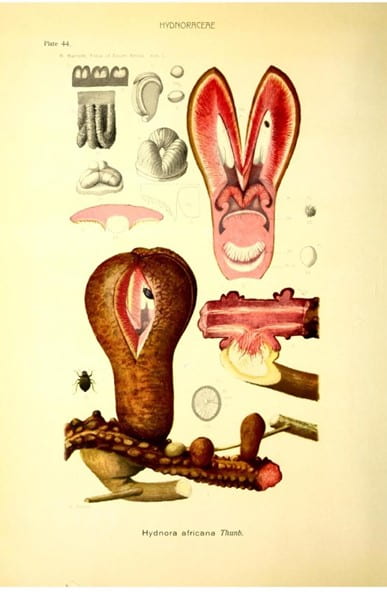
The cryptic nature and seasonal appearance of Hydnora had made European encounters with the plant, let alone the collection and preservation of any parts of its fleshy vegetative flower, extremely rare. Swedish naturalist Carl Peter Thunberg first extracted it in 1774, so Hydnora was not new when it was displayed in Jena. He did, however, struggle to grasp its singular peculiarity. He remarked, “so strange is its composition that many would certainly doubt the existence of such a plant on the face of the earth.” In an initial description published with the Royal Academy of Sciences in Stockholm, Thunberg erroneously grouped it as a fungus related to the genus Hydnum. Later botanists took some time to disprove this assertion, as it was only distinguishable from fungi when the flower had opened. This was a common problem when collecting plants out of season; the Linnaean taxonomic system was fundamentally based on the flower, making identification tricky with species that flowered infrequently. To view the type specimen in Thunberg’s herbarium, many European naturalists would have had to go to some length to travel to Uppsala, making the (relatively) freshly dried Hydnora something of a spectacle.
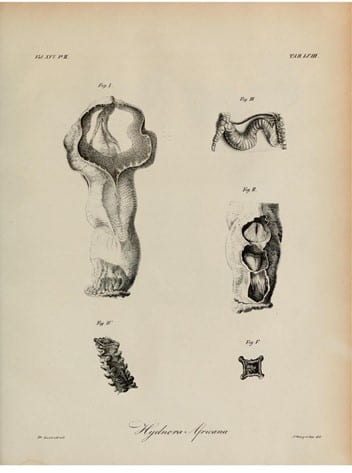
Already by 1833, Cape collectors had brought new Hydnora specimens to Europe, perhaps for the first time since Thunberg. The collectors, Christian Ecklon, Karl Zeyher, and Johann Franz Drège, all came from humble backgrounds in the German-speaking lands. Ecklon had trained as an apothecary, working for five years at the popular Pallas & Polemann pharmacy in Cape Town with Drège’s brother, Carl Friedrich, who collected zoological and entomological specimens in a partnership with his brother. Zeyher and Drège, on the other hand, were trained horticulturists. While Zeyher apprenticed with his uncle in the ducal gardens of Schwetzingen in Württemberg, Drège held positions in the gardens of Munich, Berlin, St. Petersburg, and Riga before arriving in the Cape. In this period, it was common for apothecaries and horticulturists to transition into full-scale botanical or zoological collecting, especially since both professions coupled elements of commercialism into the practice of natural history.
Ecklon, Zeyher, and Drège were part of a new generation of botanical collectors in the region, representing a shift toward ‘entrepreneurial’ collecting: men who financed their expeditions and supported themselves through the commodification of nature. As quickly as they had become companions in the field, suspicion of one another returned in consideration of the impending sale of their specimens in Europe. An 1832 letter from Drège’s brother in Cape Town warned,
‘you probably know already that Ecklon has arrived here with a collection of plants in order to take these to Germany early 1833. Zeyher will meanwhile make a trip beyond the borders in order to collect. You will probably see therefore that it would be better not to delay any further but sail over with the whole large collection.’ (from Drège Family Collection, National Library of South Africa, MSC 61.2.266, 18 October 1832).
When they arrived in Europe, both attempted to capitalize on their rare finds in German scientific journals. In the journal of the German National Academy of Sciences Leopoldina, Drège’s patron Ernst Meyer, Professor of Botany at the University of Königsberg, published a treatise describing the Hydnora africana in relation to Thunberg’s initial assessments. He also used this as an opportunity to discuss the “discovery” of a new species, the Hydnora triceps. The Berlin-based scientific journal Linnaea published a small synopsis of the treatise alongside an announcement of Ecklon and Zeyher’s sale of dried specimens, which publicized Hydnora as one of the more ‘remarkable plants’ collected on their travels. Drège and Meyer had a different approach. Because Drège did not advertise the sale of his dried collection until 1835, the choice to publish singularly on Hydnora with the Leopoldina suggests that their aim was intellectual prestige in the “discovery” of rare, new species. They were relatively successful in this regard: Drège’s name was left indelibly on the triceps’ only known host, the Euphorbia dregeana, and both Drège and Meyer’s names appeared as the taxonomic marker. They aimed for the journal of the oldest and most well-respected scientific society in the German-speaking world, and they chose Latin, not German, as their lingua franca, to reach the widest possible audience within the global scientific community.
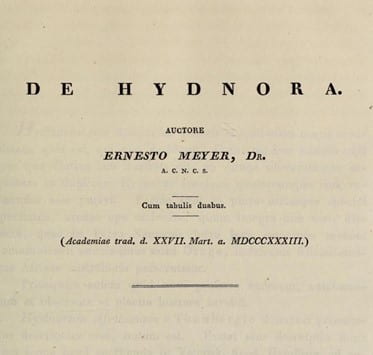
In contrast, Ecklon sought his success through the sale and distribution of his specimens. His commercialism is evident in his straightforward elaboration of collecting localities, placing such a complex find as Hydnora merely among an array of other popular Cape plants. While he does mention the publication of his and Zeyher’s forthcoming Enumeratio, the title gives away its superficial contents. Because Ecklon-Zeyher’s collection was simply a list with basic descriptions, the Enumeratio suggested that the sale of specimens was more important than any “philosophical” work on the material. Not before long, European demands for Hydnora reached South Africa. After the departure of Ecklon and Drège in 1833, Zeyher remained in the Colony as one of two experienced botanical collectors. The other was Hamburg-born physician Ludwig Pappe, who began collecting to branch out from medicine into a botanical vocation. The two Cape scientific patrons of this period, Baron von Ludwig and William Henry Harvey, implored Pappe and employed Zeyher to fulfill European desiderata. In fact, Pappe obtained the only dried specimen of Hydnora available in the Cape. Professor of Botany at the University of Glasgow, William Jackson Hooker, had requested the specimen from the Baron in 1833, presumably after news had spread that Ecklon-Zeyher and Drège had collected Hydnora. Despite their scarcity, which would not have been unknown to Hooker, the Baron seemed confident that Pappe could extract more specimens, not only dried but also in spirits. It took two years to deliver on this promise; Pappe collected specimens from Worcester in the vicinity of the Hex River, promptly dried them, and placed one in wood vinegar, a preserving agent.

While the Sixth Frontier War (1834-36) rendered plant collection in the eastern districts nearly impossible, the material nature of Hydnora made procuring a sample a difficult task for collectors. Because its structure changed so drastically in the drying process, it was poorly represented in European herbaria and led to challenges in taxonomic determination. This sparked enormous controversy and debate: how could botanists classify plants without seeing them in situ and what characteristics should be considered in classifying and determining flowers that “appeared decidedly afloral?” In revising his classification of the corpse flower (Rafflesia arnoldii) in 1834, British botanist Robert Brown used the newly arrived Hydnora specimens from Ecklon-Zeyher, Drège, and Pappe to discuss possible affinities of the two parasites and whether they should be classed together. He believed there were points in Hydnora’s structure which threw “some light on one of the most difficult questions respecting Rafflesia,” allegedly bringing him to more fully realized conclusions about the nature of parasitism.
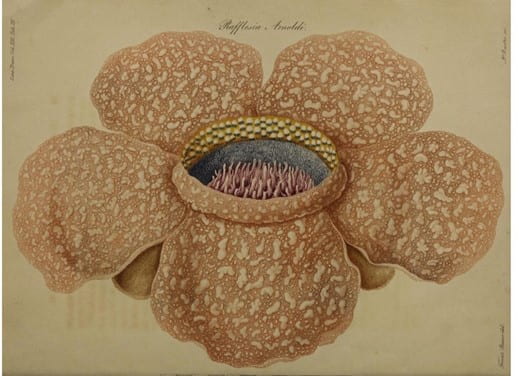
However, Brown’s student, British botanist William Griffith, fundamentally disagreed. His contentions were both taxonomic and material, and the latter wholly informed the former. Based on his fieldwork in situ, he concluded that Rafflesia and Hydnora were not similar in their parasitism, nor should parasitism be used as the singular point of comparison. But Griffith, and before him Austrian botanist Franz Unger, held that such a complicated process should only be conducted in the field using live plants. Although Griffith found the herbarium specimens Brown used to be useless evidence in supporting his hypothesis, he had, in fact, never seen Hydnora in its natural habitat to make any comparisons. Acting somewhat hypocritically in his derision of Brown, the specimens Griffith examined were “both in the dry state and in … pyroligneous acid,” clearly the examples that Pappe had collected years earlier. Amongst themselves, botanists could not agree where to study traits like parasitism, and Hydnora africana was a central point in the debate.
For Brown and Griffith, the impenetrability of Rafflesia was essentially tied to their understanding of its tropical home in the Sumatran rainforest. The corpse flower, like many unusual and exotic plants, did not fit into their taxonomic assumptions of the natural environment. Yet, botanists dwelled very little on the landscape which gave life to Hydnora, omitting it from grandiose portrayals and popular imaginings. In their mind, they separated the desert plant from its desert environment. The moment these collectors detached Hydnora from its Euphorbia root, an indigenous African plant was both materially and intellectually abstracted to fit it into Western notions of scientific knowledge. In attempts to understand the essence of parasitism, Hydnora both resisted and facilitated human understanding. While we have a better grasp of its place amongst other parasitic plants in the floral kingdom, Hydnora has only been successfully cultivated once outside of southern Africa, illustrating that even today the plantposes difficulties for botanists. Hydnora’senigmatic character, though, was not lost on those who studied it. This abstraction is best embodied by German botanist C.G. Nees von Esenbeck: “Aphyteja Hydnora thus stands as a hieroglyphic key between two worlds, which like dream and waking, are laid out in an endless interrelationship and flee before us.”
Katherine Arnold is a fourth-year PhD student at LSE studying German ‘entrepreneurial’ natural history collectors in southern Africa (1815-1867). Her research interests include Anglo-German relations, imperial history (British, Dutch, and German), and the history of science.
Featured Image: William Griffith, ‘On the Root-Parasites Referred by Authors to Rhizantheae: and on Various Plants Related to Them’, Transactions of the Linnean Society, 19 (1845).
